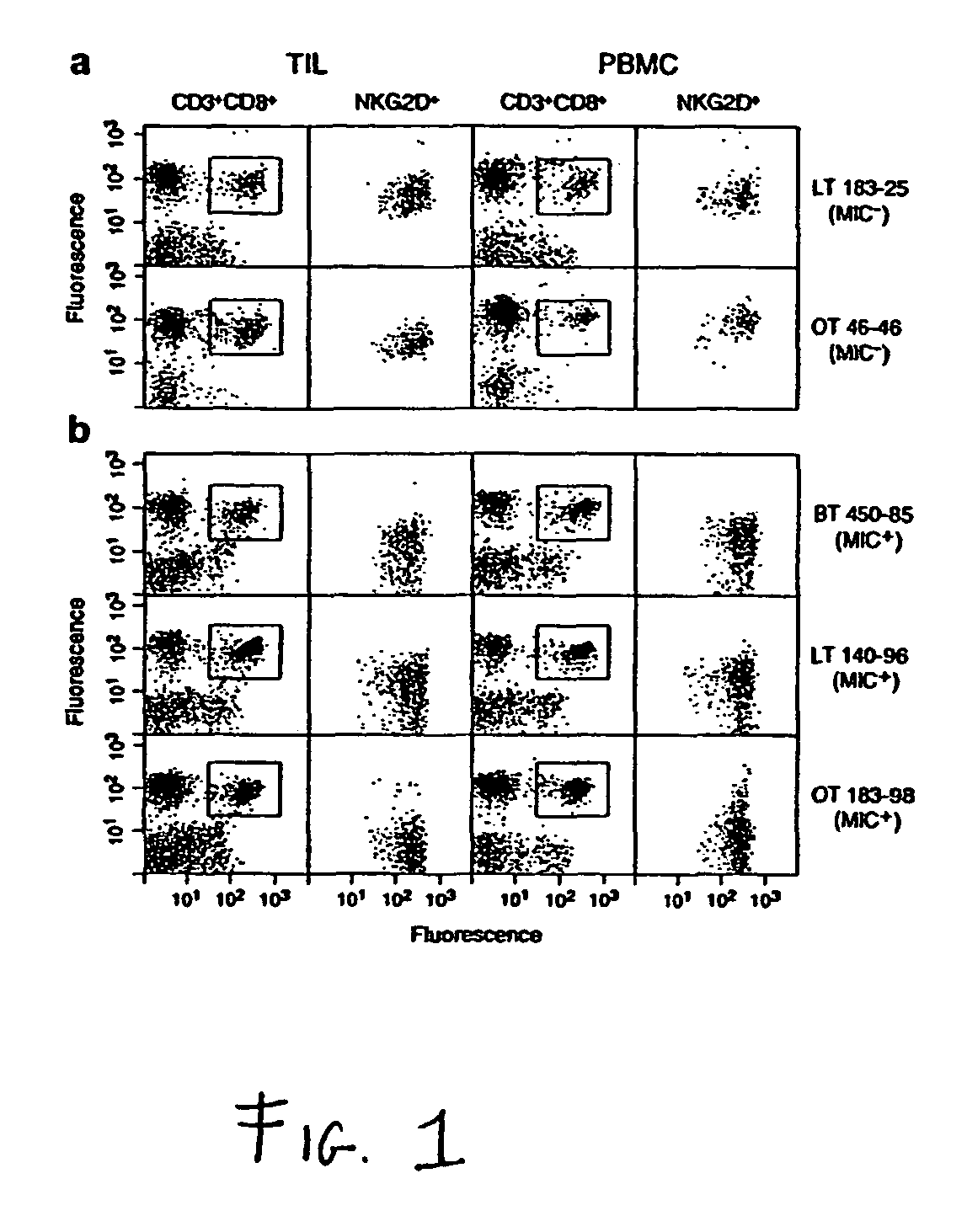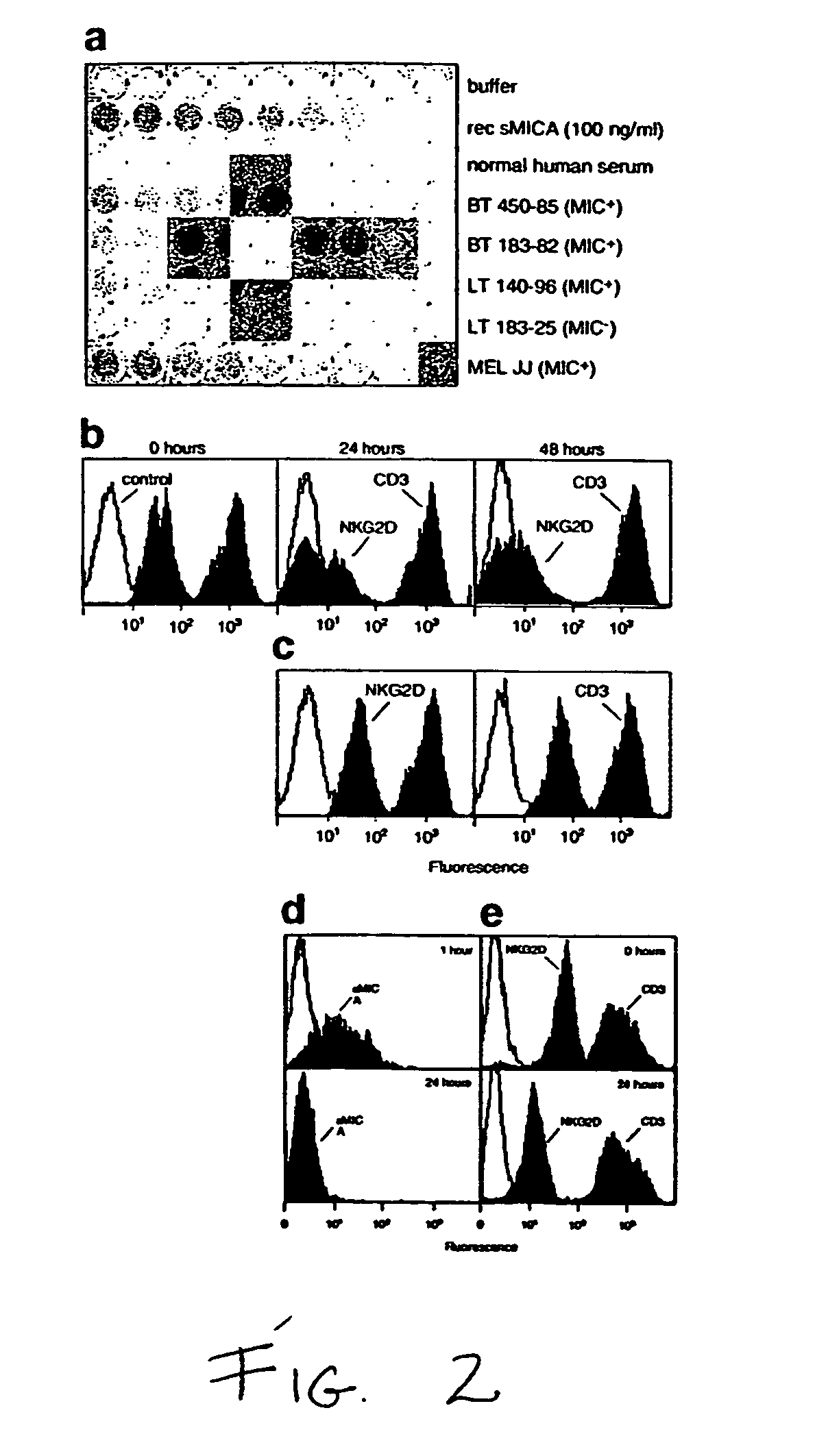Soluble MIC polypeptides as markers for diagnosis, prognosis and treatment of cancer and autoimmune diseases or conditions
a technology of soluble mic polypeptides and markers, applied in the field of immunology and oncology, can solve the problems of cancer still undetected in a large number of patients, too far advanced diseases, limited therapeutic options, etc., and achieve the effect of systemically reducing the level of nkg2d on cd8 t cells
- Summary
- Abstract
- Description
- Claims
- Application Information
AI Technical Summary
Problems solved by technology
Method used
Image
Examples
example 1
Material and Methods for Example 2
Assay of Soluble MIC
[0256]For the assays, serum and pleural effusion samples were screened by ELISA using different pairs of anti-MIC mAbs with non-competing binding specificities (α1α2 or αα3 domain epitopes (Groh et al. Proc. Natl. Acad. Sci. USA 93: 12445-12450, 1996; Groh et al. Science 279: 1737-1740, 1998). For antigen capture and detection, ELISA plates were coated with selected capture mAbs, washed and blocked following standard procedures, incubated with serial dilutions of sample and treated with biotinylated detection mAbs. Washed plates were incubated with streptavidin-HRP, washed and reactions developed with tetramethyl-benzidine substrate. In parallel, already available purified recombinant sMICA were used to calibrate the assays.
ELISA Technique
[0257]The inventors developed an ELISA technique for the detection of soluble MIC using three different pairs of selected mAbs with non-competing epitope specificities. Preliminary data showed t...
example 2
MIC is Shed from Tumor Cells
[0258]The inventors' results demonstrate that cell surface MIC alone, in the absence of TCR engagement, is sufficient to induce downmodulation of NKG2D on CD8 alpha beta T cells. Moreover, the repeatedly observed diminished expression of NKG2D not only on TIL but also on peripheral blood T cells from patients with MIC-positive tumors raises the. question of whether this effect may be caused by soluble MIC shedded from tumor cells or whether it is due to transient contacts of circulating T cells with tumor cells (FIG. 1). The inventors show in FIG. 2 that this effect can be caused by soluble MIC shed from tumor cells.
[0259]The inventors investigated NKG2D expression on TIL and PBMC from patients with tumors that were positive or negative for MIC expression. The materials used included 27 paired tumors (5 colon, 5 ovarian, 7 lung, 6 breast carcinomas and 4 melanomas), TIL and peripheral blood samples. Freshly prepared tumor cell suspensions were tested for ...
example 3
Materials and Methods Relevant to Embodiments Herein
Production of Monoclonal Antibodies.
[0260]RBF / DnJ mice (The Jackson Laboratories; Bar Harbor, Me.) were injected intraperitoneally three times at weekly intervals with 108 C1R cells expressing MICA mRNA after stable transfection with MICA cDNA in RSV.5neo. After a final boost immunization, isolated splenocytes in suspension were fused with P3-X63Ag8.653 myeloma cells (Kearney et al., 1979) by standard polyethylene glycol treatment (Harlow and Lane, 1988). Hybridomas were grown in RPMI media with 10% of each CPSR-3 heat inactivated serum replacement controlled process type 3 (Sigma, St. Louis, Mo.) and Hybridoma Enhancing Supplement conditioned cultured medium from a murine lymphoma cell line (Sigma, St. Louis, Mo.) in 96-well plates under HAT (hypoxanthine aminopterin thymidine) selection on irradiated MRC-5 feeder cells (Harlow and Lane, 1988). Supernatants were differentially screened for specific reactivity with C1R-MICA cells v...
PUM
| Property | Measurement | Unit |
|---|---|---|
| viscosity | aaaaa | aaaaa |
| viscosity | aaaaa | aaaaa |
| temperatures | aaaaa | aaaaa |
Abstract
Description
Claims
Application Information
 Login to View More
Login to View More - R&D
- Intellectual Property
- Life Sciences
- Materials
- Tech Scout
- Unparalleled Data Quality
- Higher Quality Content
- 60% Fewer Hallucinations
Browse by: Latest US Patents, China's latest patents, Technical Efficacy Thesaurus, Application Domain, Technology Topic, Popular Technical Reports.
© 2025 PatSnap. All rights reserved.Legal|Privacy policy|Modern Slavery Act Transparency Statement|Sitemap|About US| Contact US: help@patsnap.com


